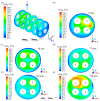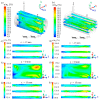A New Design of Tubular Ceramic Membrane Module for Oily Water Treatment: Multiphase Flow Behavior and Performance Evaluation
- PMID: 33297473
- PMCID: PMC7762366
- DOI: 10.3390/membranes10120403
A New Design of Tubular Ceramic Membrane Module for Oily Water Treatment: Multiphase Flow Behavior and Performance Evaluation
Abstract
Petroleum has been extracted from oil reservoirs using different techniques. This activity is accompanied for a large amount of water and sometimes mixed with gas. This produced water has a high oil concentration and other toxic chemical compounds, thus, it must be treated to be reused or released to environment according to environmental protection regulations. Currently, ceramic membrane technology has been employed in the wastewater treatment, due to its high benefit-cost ratio. In this sense, this work aims to study the oil-water mixture separation process using a new configuration of tubular ceramic membrane module by computational fluid dynamic (ANSYS Fluent software). The proposed model is composed of mass and linear momentum conservation equations coupled to Darcy's law and SST k-ω turbulence model. Results of the volumetric fraction, pressure, and velocity distribution of the oil and water phases are presented and discussed. The results indicated that the proposed model and new device both have great potential to be used on the water/oil separation process and that the transmembrane pressure remains constant in the axial direction and decreases radially through the membranes, indicating an efficient system that favors the transport of clean water and oil retention.
Keywords: ANSYS Fluent; computational fluid dynamics; membrane filtration; produced water.
Conflict of interest statement
The authors declare no conflict of interest.
Figures















References
-
- Igunnu E.T., Chen G.Z. Produced water treatment technologies. Int. J. Low-Carbon Technol. 2014;9:157–177. doi: 10.1093/ijlct/cts049. - DOI
-
- Khan F.A., Hisham S., Ghasemi M. Oil field produced water recovery and boosting the quality for using in membrane less fuel cell. SN Appl. Sci. 2019;1:510. doi: 10.1007/s42452-019-0523-3. - DOI
LinkOut - more resources
Full Text Sources

